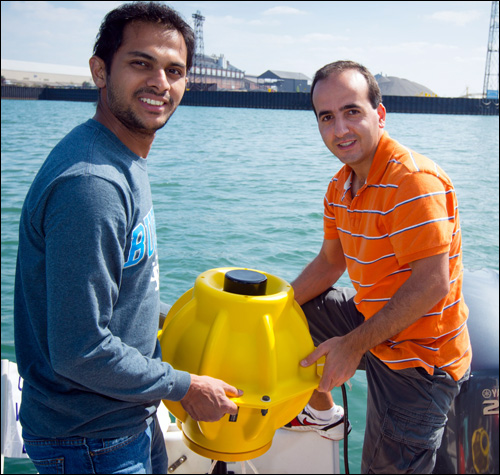Researchers at the State University of New York at Buffalo (UB) are testing a wireless underwater network of nodes that chirp acoustic, rather than RF, transmissions from lake or ocean floors to a receiver on the water’s surface, and then forward that data to the Internet via a cellular connection. The underwater nodes transmit at 11.5 kHz, forming a network that forwards data over the course of potentially many miles, back to a receiving node linked to software on a back-end system at the water’s surface. When sensors, such as temperature-measurement devices, are built into or wired to the unit, that unit can then transmit information regarding changes in the water.
The system, developed by UB’s Wireless Networks and Embedded Systems (WiNES) Laboratory, could eventually enable scientists to track undersea conditions. The collected data then could be used not only to predict tsunamis or other natural disasters, but also to locate underwater oil or natural gas sources, or to monitor fish and marine mammals within the vicinity.

The underwater devices that the researchers are currently testing, with funding provided by the National Science Foundation, are designed to work similarly to RF-based wireless sensor nodes that collect data on land, using technology such as active RFID, ZigBee, Wi-Fi or Bluetooth. These RF-based wireless sensors do not transmit signals well through water, explains Tommaso Melodia, a UB associate professor of electrical engineering, the WiNES Lab’s director and the project’s lead researcher. Therefore, he says, the research group has been testing battery-powered underwater acoustic modems, supplied by Teledyne Benthos, that transmit data via acoustic waves that can be heard by the human ear.
The acoustic modem is built into a spherical glass dome and is protected by a very thick enclosure to sustain the high pressure at the bottom of a lake or ocean. To help keep it submerged, the unit attaches to a 12-pound anchor. The receiver is a surface buoy that receives or sends acoustic waves from or to the underwater units, converting those signals to meaningful data sent by a 3G cellular dongle installed inside the buoy’s modem to a server set up by the researchers. To date, the data transmitted by buoy has been accessed by a laptop located on the researchers’ boat, but the long-term plan is to set up a permanent solution by which the server receiving data via 3G transmission can be accessed by individuals equipped with laptops or smartphones, or by a computer or laptop located on land near the research site.
In that way, the team explains, users can access real-time data from under water via a computer or smartphone.
Once submerged, any sensors built into the unit will collect data about the water. That information would be sent in chirps, along with a unique ID number, hopping from one underwater acoustic modem device to another, and on to the surface buoy unit. Once each test is finished, researchers instruct the buoy units to send a message to the underwater units, instructing them to release themselves from their anchors—the act of which brings the modems to the surface.
Researchers intend to conduct further testing in Lake Erie during the next six weeks, Melodia reports. “We hope to be able to do two more deployments before mid-November,” he says, after which the cold conditions and ice would make it impossible to take a boat into the lake. During these deployments, the researchers will test the transmission of data received by the surface buoy to a server, via a 3G cellular connection. He says the team may use four or five underwater units, which could be spaced up to a mile apart.
Research team member and UB graduate student Hovannes Kulhandjian says he is also designing a mobile phone application that would enable phone users to receive regular updates and alerts from the Web site where data is stored.
So far, the research has been focused on transmission capabilities rather than on underwater sensors, so no sensors have yet been tested. However, the researchers note, a variety of underwater sensors could be wired to—or be built into—the units, thereby sending data such as water flow or temperature changes.
In the long run, Melodia says, the group hopes to commercialize the technology for use in disaster prevention, pollution monitoring or oceanographic data collection. It could also be utilized to police waters, by detecting drug-smuggling submarines. However, he adds, there is no specific timeline for selling the system. “For now,” he states, “we have concentrated on the research aspects.”
At The 8th ACM International Conference on Underwater Networks & Systems conference, to be held in Taiwan on Nov. 11-13, the research group will present a paper describing its efforts, titled “The Internet Underwater: An IP-compatible Protocol Stack for Commercial Undersea Modems.”


